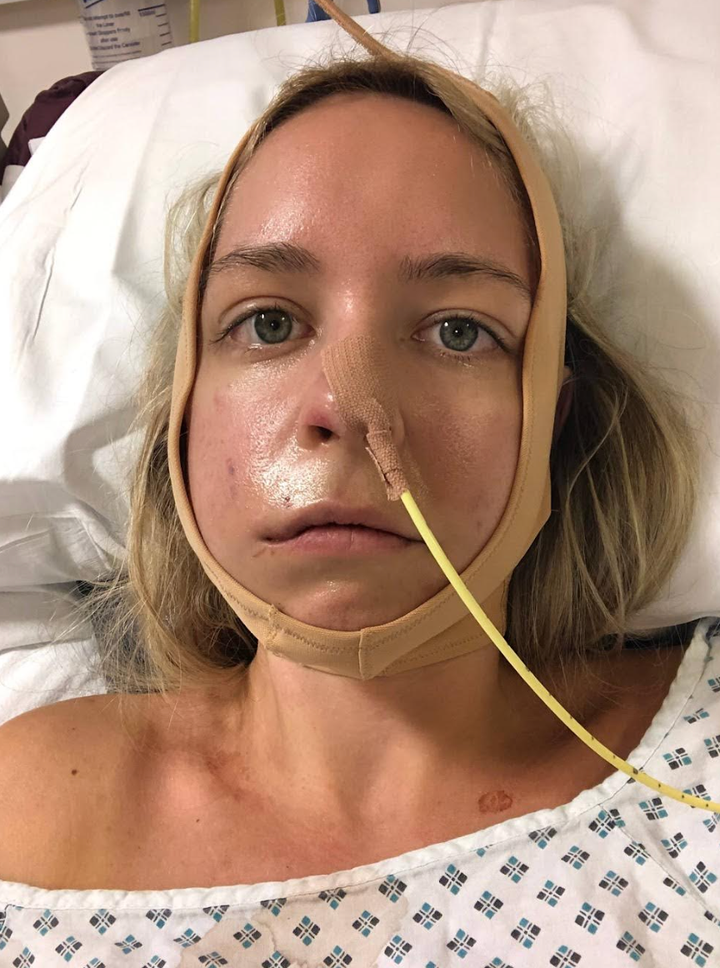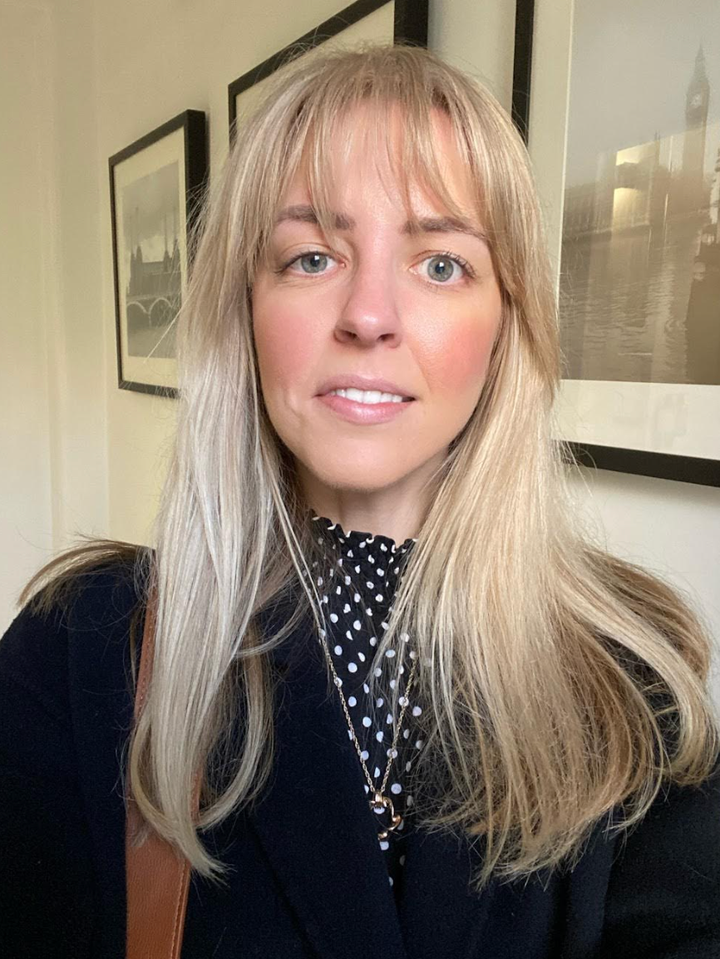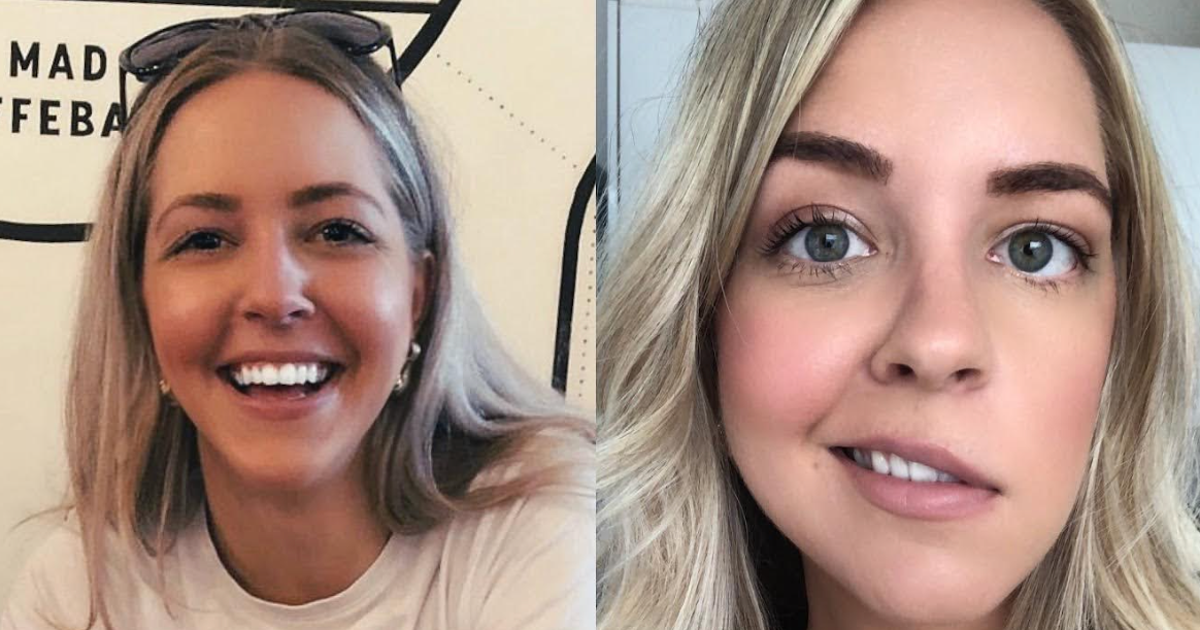In a world obsessed with appearance, it’s easy to let our physical differences define us. For years, I lived under the comforting umbrella of stereotypical beauty — unaware of the journey that awaited me. But in 2019, at the age of 25, my life took an unexpected turn overnight when I underwent brain surgery to remove a tumor. During the surgery I suffered a stroke, which left me unable to walk or write, and with the sensation that the world is constantly moving.
Due to nerve damage, the right side of my face was also permanently paralyzed. When I woke up, everything was different, mostly in the way I saw the world and in the way it saw and treated me. I was petrified — not only by the scale of the journey ahead, but also by what my life would now look like.
In 2020, I became the first person in the U.K. to undergo a pioneering smile surgery, in which nerve and blood vessels were grafted from my right calf to my upper lip, to give power to my affected side.
The results weren’t immediate, and it took a further three years of physiotherapy to learn to smile again and engage my bite muscles. However, with time, the surgery enabled me to regain some of the expressions I’d lost when I woke up unable to communicate on my right side.
Immediately following my onset of facial paralysis, there was a constant battle between embracing my authentic self and succumbing to the unrealistic standards set by social media. I felt an unspoken expectation to hide or minimize the aspects of my appearance that strayed from the norm, and pinned all hopes on my smile surgery erasing the difference caused by the stroke.
But the surgery didn’t erase it completely. An element of my facial paralysis will always remain and, with hindsight, I’m able to see this as a positive — as evidence of the journey I’ve been on, which has been marked by strength, resilience and self-acceptance.

My appearance before I experienced nerve damage in my face fit the mold that society deemed acceptable, and I never questioned my worth based on my looks. But when I gained my visible difference at 25, everything changed. Suddenly I was confronted with stares, whispers and the harsh reality that I no longer fit the conventional definition of physical beauty. I became aware of just how much emphasis is placed on looks when I could no longer walk down the street without attracting negative attention or questions on why my mouth is “wonky.”
It became difficult to socialize and meet new people, which I did so effortlessly before. And I could tell my difference made others uncomfortable because they seemed unsure of what to say, so I often felt avoided altogether.
I initially struggled to reconcile my new appearance with my sense of self. I felt the same inside, but was constricted by an unrecognizable cage. I mourned the loss of what I’d looked like before. I realized I had never fully appreciated it, and I grappled with feelings of insecurity and self-doubt.
The unhappiness and anxiety surrounding my visible difference were heightened by being part of the Instagram generation. The pressure to conform to unrealistic beauty standards seen on social media felt overwhelming. I was constantly bombarded by images of flawless faces and flawless lives. Seeing photos of others online — especially people of my age buying houses, traveling, getting engaged and doing things that were unattainable for me at that time — intensified my struggle with confidence and self-acceptance.
I had grown up thinking these things were synonymous with appearance and now deemed them unachievable for me. Each time I scrolled through my feed, I was reminded of the stark contrast between the curated perfection displayed online and my new appearance. I compared myself with others and concluded that being unlike them was a negative thing, without fully appreciating that everyone is on their own journey in life.
After years of feeling less-than and putting my life on hold, I found a glimmer of hope — a newfound appreciation for the beauty in imperfection. For the first two years following my surgery, I was too focused on learning to walk, write and balance alone again to give full attention to my difference, and part of me was able to hide behind this. That was even truer during the COVID-19 pandemic, when wearing a mask was the norm.
But after a period of victim-blaming, depression and feeling a total loss of control about my looks and the cards I’d been dealt, I realized that how I reacted was completely within my control. I couldn’t change what had happened to me, but I was the only one who had the power to define my worth and choose how my story unfolded.
I knew that the only thing stopping me from fully living a happy life was me and my choices. And the decision to no longer let my looks dictate the life I live was liberating.

My journey to self-acceptance didn’t happen overnight. It required a shift in mindset, one in which I stopped seeking validation from others and started embracing my uniqueness. Instead of mourning the loss of my old appearance, I began to celebrate the beauty in my visible difference. I reminded myself that my worth isn’t determined by society’s standards; it’s defined by my character, kindness for others and resilient spirit. Whenever I felt triggered by comments, I remembered why I look the way I do and that it’s because of a surgery that saved my life.
The most empowering decision I made was to stop letting negative comments affect me. There’s a wave of relief that comes with letting go of what others think of you, knowing that it isn’t fact. Instead of internalizing hurtful words, I decided that people’s opinions are either a simple curiosity because I look different, or a reflection of their own insecurities, not a measure of my worth.
I learned that acceptance is something that comes in waves, and it’s OK to struggle with your appearance some days. So many of us long for something that we once had, or that others seem to have now. We’re subjected to photo filtering and artificial intelligence tools, perpetuating the harmful notion that beauty is defined by perfection. And we’re usually only shown a highlight reel of people’s lives with no idea of what challenges they’re facing. As a result, we’re left feeling inadequate, less-than and as though our worth is measured by how closely we resemble the airbrushed images that flood our screens.
But when we’re comparing, we’re focusing on what we don’t have. So I started creating lists of my strengths and achievements that weren’t related to my appearance. Challenging negative beliefs about my social life and dating prospects showed me that external looks don’t dictate my worth. This process revealed that who I am internally far outweighs any external judgments. The outcome is that I no longer feel that my visible difference will be an indication of the friendships I make or experiences I have.
With my growing confidence, I began to embrace life fully and stopped hiding behind insecurities. I started traveling solo again to new places, trying new experiences and challenging myself to step out of my comfort zone. I ran a 10K race after being unable to walk. I paddleboarded after being unable to stand alone. And I founded a business helping others overcome adversity after being forced to change careers due to my visual impairment.
I’ve made lifelong friends since my brain surgery — friends who didn’t know a previous version of me — and I’ve actively put myself in situations where I know I will probably face comments from others, like when I’m volunteering with little children and giving talks in schools.
Each accomplishment is a boost to my self-esteem, and each adventure is a reminder that we are all capable of anything we set our minds to. As I opened myself up to connecting with others again, I saw the beauty in human connection, learning that everyone has their own stories, perceived flaws and insecurities.

Embracing my visible difference has been a liberating journey — one filled with challenges, triumphs and endless self-discovery. When we’re going through a difficult time, we want it to end because it feels unbearable at that moment. But I’ve learned that you need to go through it for it to shape you. You’ll eventually know what all that pain was for, and when you do, you won’t waste it.
Through self-acceptance and self-confidence, I’ve learned to celebrate what makes me unique and stopped allowing negative comments to define me. I made the decision to unapologetically accept myself, ready to take on whatever life throws my way. I determined that my life wasn’t over when I woke up from brain surgery, changed and uncertain about the future — I simply had to find a new way to live it.
Whatever your appearance or perceived flaw, your uniqueness is your strength, and you are worthy of love and acceptance just as you are. In a world where authenticity is often overshadowed by filters and retouching tools, it’s more important than ever to challenge societal norms and redefine beauty on our own terms. It took a visible difference for me to realize that true beauty goes beyond physical appearance and lies in the strength, resilience and authenticity of each individual. Never let anyone dull your sparkle or dim your light. You are enough, exactly as you are.
Sammy Taylor is the founder of www.beautybrainuk.com, an award-winning writer and a keynote speaker. Her mission is to inspire, empower and support others overcoming setbacks with tools to aid resilience, confidence and acceptance. If you’re looking for ways to boost positivity and shift your mindset, sign up for her free tips at www.beautybrainuk.com.
Do you have a compelling personal story you’d like to see published on HuffPost? Find out what we’re looking for here and send us a pitch at [email protected].







